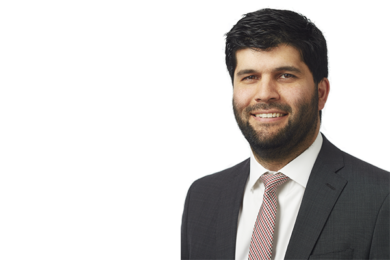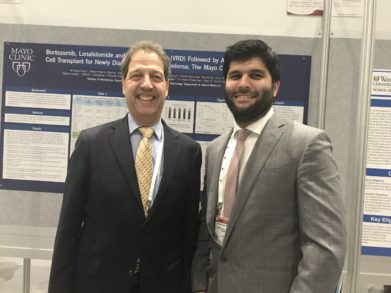New amyloidosis drugs and clinical trials update
A new class of drug may soon be available to Australian patients with significant cardiac AL amyloidosis in a Phase III clinical trial, expected to open in mid-2020.
The monoclonal antibody, currently called CAEL101, was designed by the Columbia University Amyloidosis group in the U.S. to bind on to the amylogenic protein and help clear it from the body.

“It’s a different class of drug,” said Dr Hasib Sidiqi, a consultant haematologist at Fiona Stanley Hospital (Perth). Last October, he returned to Australia from a two-year scholarship at the Mayo Clinic (Rochester, U.S.) where his focus was myeloma, amyloidosis and bone marrow transplantation.
Speaking to Amyloidosis News about treatment developments and clinical trials in the pipeline for AL amyloidosis, Dr Sidiqi said treatments generally targeted the plasma cells that produce the amyloidogenic protein. The aim being “to try to kill them off, so you’re shutting the factory of production”.
“CAEL101 targets the actual amyloidogenic protein, to try and help clear it from the body and hopefully even help clear it from the organs that are affected.”
Early Phase I/II studies of CAEL101 showed efficacy, particularly for patients with cardiac involvement, said Dr Sidiq.
Now CAEL101 it is being considered for a Phase III trial, where it would be used in combination with standard therapy – cyclophosphamide, bortezomib and dexamethasone (CyBorD); the regimen commonly used for newly diagnosed amyloidosis patients.
This trial is undergoing feasibility assessment at several centres in Australia, including the Fiona Stanley Hospital.
“If selected, we hope to open the trial later on this year,” said Dr Hasib Sidiqi.
The link between myeloma and amyloidosis treatment
Treatments used for AL amyloidosis tend to be borrowed from the treatments that work for myeloma.
“If we look at amyloidosis pathophysiologically*, abnormal plasma cells produce the amyloidogenic light chains that are then deposited in tissues and cause organ disfunction,” said Dr Sidiqi.
“So, the goal of treatment is to try and stop production of those light chains and we’ve realised that the same treatments that we’ve used for myeloma – a cancer of the plasma cells – work quite well in amyloidosis.
“Amyloidosis patients have unique challenges because organ involvement with cardiac and kidney dysfunction is more common than what we see in myeloma patients.
“The key treatments we have tried over the last 5-10 years have used bortezomib (Velcade®)-based treatment,” he said.
“It works very well for AL amyloidosis and the best data on that treatment comes from the UK National Amyloidosis Consortium.
“They recently published a trial of 900 patients treated with Velcade/bortezomib-based regimens up front for amyloidosis and they showed very promising results.
“Most people will respond to this therapy and those who achieve good responses can go on to have several years without the disease relapsing. That gives us further evidence that the treatment we’ve been using for several years now actually has very good outcomes.”
Dr Sidiqi said some of the other myeloma drugs that are available pose unique challenges in patients with AL amyloidosis and gave the example of carfilzomib.
“It can cause cardiovascular issues such as high blood pressure and, in some patients, heart failure although this is less common,” he said.
“But in our amyloidosis patients, who may already suffer from heart disfunction, carfilzomib is very poorly tolerated, so that is a drug we try and avoid.
“Likewise, other drugs like the immunomodulatory drugs – lenalidomide (Revlimid®) and pomalidomide (Pomalyst®) – tend not to be so well tolerated in the amyloidosis patients as the myeloma patients. Although they have been looked at in smaller studies, overall their use is limited in AL amyloidosis.”
Daratumumab and AL amyloidosis
What Dr Sidiqi said had emerged as a success story in the last 12-24 months was the use of daratumumab (Darzalex®), a monoclonal antibody to CD38, in patients with AL amyloidosis.
“We know daratumumab is a highly effective treatment in myeloma. It’s used in all stages of the disease, from upfront to relapsed settings,” said Dr Sidiqi.
“The first early trials of daratumumab used in AL amyloidosis were reported at the 2017 annual meeting of the American Society of Hematology. One trial from Boston (U.S.) and one from the French group, Intergroupe Francophone du Myélome (IFM), showed that patients with AL amyloidosis treated with daratumumab do exceptionally well.
“They respond, and they respond very quickly, with the majority of responses seen in the first cycle of therapy, and there have been some really amazing responses with people achieving a deep response even after one dose of the drug!
“Those early positive results then translated into an expansion of clinical trials,” said Dr Sidiqi.
One trial is looking at daratumumab in combination with bortezomib, cyclophosphamide and dexamethasone compared to bortezomib, cyclophosphamide and dexamethasone as upfront therapy.
“So, we’re looking at whether the addition of the daratumumab to the existing triplet of drugs that we were using for newly diagnosed patients would add any benefit. That trial opened in a few Australian centres but is now closed to recruitment.
“I think it’s going to show some promising results. We’re eagerly awaiting that because it could really help improve our options for treating AL amyloidosis.
“Daratumumab is a really exciting drug for AL amyloidosis,” said Dr Sidiqi.
“Currently our access to daratumumab in Australia is limited. Myeloma patients are able to access this through Janssen’s compassionate access program. I believe daratumumab is being resubmitted this year to the Pharmaceutical Benefits Advisory Committee for consideration.
“Unfortunately, as far as I am aware there aren’t any trials with daratumumab targeting the AL amyloidosis patient population that are currently open in Australia.”

AAN-initiated clinical trials
However, Dr Sidiqi said the Australian Amyloidosis Network (AAN) – a group of physicians from across the country with four amyloidosis centres – is considering two new Phase II trials for people with AL amyloidosis.
“One is to consider daratumumab in combination with a couple of medications that we sometimes use for AL amyloidosis – melphalan (Alkeran®) and dexamethasone – in patients who have relapsed disease,” he said.
“If they’ve already had CyBorD, that would be a very good trial to have open. It would give these patients access to what we know is a really effective drug for AL amyloidosis.”
Dr Sidiqi said plans are for this trial to be run in collaboration with the Australasian Leukaemia & Lymphoma Group and to recruit 40-60 Australian patients.
The second trial is for isatuximab, a monoclonal antibody to CD38 which has a slightly different structure to daratumumab but is in the same class. It already has been tested and found to be effective in treating myeloma.
“We are working in collaboration with the French group, IFM, to see if we can open a clinical trial using isatuximab in combination with pomalidomide and dexamethasone,” said Dr Sidiqi.
This trial also would be in the relapsed setting, “so if you’ve had treatment before and your disease has come back, that’s what we would be targeting”.
“We hope to open the isatuximab trial in Australia at two or three AAN centres. Again, that would allow us to access what we hope is going to be a very effective drug for AL amyloidosis.”
Both trials are in the negotiation and discussion phase with the industry sponsors that would support the clinical trials.
Dr Sidiqi said autologous stem cell transplantation also was a treatment option for a select group of patients.
“You have to have very good organ function and you need to have a good performance status to be considered for that but that’s another option.”
Dr Sidiqi is a member of the AAN, which covers all the amyloidoses.
As good data is not available on the incidence sand prevalence of amyloidosis in Australia, Dr Sidiqi said the AAN also was looking at doing epidemiology studies to gather this information.
Members of the AAN catch up once a month by teleconference.
“It’s a good forum for us to discuss tricky patient cases and come up with a consensus on a treatment plan,” he said.
“While most people with amyloidosis are treated at one of the AAN’s four city centres – in Brisbane, Sydney, Melbourne and Perth – that doesn’t capture all of Australia.
“It’s likely that a lot of other patients are being treated elsewhere by our haematologist colleagues. We are very accessible for opinions as a group and are happy to discuss cases with anyone who wishes to,” said Dr Sidiqi.
* The study of structural and functional changes in tissue and organs that lead to disease.
Last updated on January 3rd, 2023
Developed by the Leukaemia Foundation in consultation with people living with a blood cancer, Leukaemia Foundation support staff, haematology nursing staff and/or Australian clinical haematologists. This content is provided for information purposes only and we urge you to always seek advice from a registered health care professional for diagnosis, treatment and answers to your medical questions, including the suitability of a particular therapy, service, product or treatment in your circumstances. The Leukaemia Foundation shall not bear any liability for any person relying on the materials contained on this website.